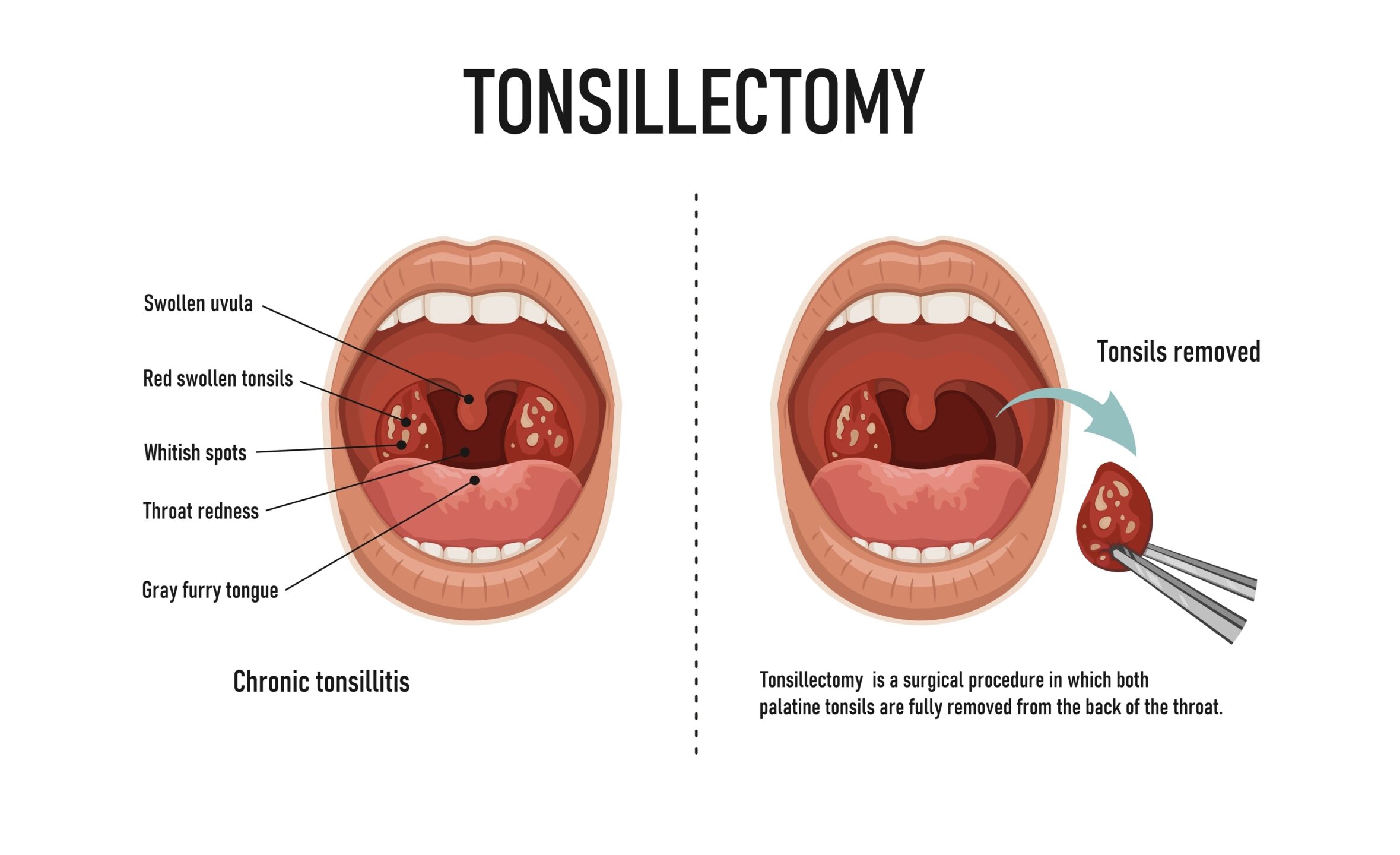Access your own patient portal, provided by NCSH.
Ear, Nose & Throat
Understanding a Tonsillectomy: When and Why It's Needed
Mon, May 06, 2024

With approximately 700,000 performed each year, a tonsillectomy is a common procedure. That’s a lot of soothing ice cream. But did you know that while tonsillectomies are often thought of as children’s surgeries, they’re common among adults, too? Close to 300,000 of that total are performed each year on people over the age of 18!
But while tonsillectomy in children is a fairly common surgery, it’s critical to know what to expect for the best possible outcome if you or a family member needs one, especially if you’re an adult. The ear, nose, and throat specialists at North Carolina Specialty Hospital explain what you need to know.
From Sore Throat to Surgery: Tonsillectomy Talking Points
The tonsils are two small, fleshy glands located at the back of the throat to which we don’t pay much—if any—attention until they become painful. Their job is to filter out germs that enter the body through your nose and mouth to keep them from traveling throughout your body and causing infection.
While the tonsils play an important role, there are certain situations where their removal becomes necessary.
What Is a Tonsillectomy?

This is the surgical procedure that removes the glands and the tonsil infection.
Three Reasons Why Tonsils Are Removed
- Recurrent tonsillitis. Tonsillitis is an inflammation of the tonsils caused by bacterial or viral infections. If a person experiences chronic throat infections and does not respond well to conservative treatments such as antibiotics, surgical removal of the tonsils may be recommended.
- Sleep-disordered breathing, particularly in children. Enlarged tonsils can obstruct the airway during sleep, leading to conditions such as obstructive sleep apnea, a serious sleep disorder where breathing repeatedly stops and starts during sleep. Removing the tonsils can help open the airway and improve breathing during sleep.
- Complications from tonsillitis or other tonsil-related conditions. These can include abscess formation, recurrent or chronic infections, difficulty swallowing, and enlargement of the tonsils.
What Happens During a Tonsillectomy?
The tonsillectomy is typically performed under general anesthesia. The surgeon will use specialized tools to remove the tonsils from the throat.
How Long Does a Tonsillectomy Take?
The procedure usually takes about 30 minutes to an hour but varies depending on individual circumstances.
After surgery, it is normal to experience some discomfort and pain in the throat. It is important to follow the postoperative instructions provided by your health care provider to ensure a smooth recovery. You should recover within two weeks after surgery, barring any complications.
Tips for a Quicker Tonsillectomy Recovery:
- Take pain medication as prescribed to help manage any discomfort after the surgery.
- Stay hydrated by drinking plenty of fluids, such as water or clear liquids. Avoid drinking acidic or carbonated beverages, as they can irritate the throat.
- Rest and take it easy after the surgery. Avoid any strenuous activities that could strain your throat or slow down the healing process.
- Use a humidifier: Dry air can irritate the throat and prolong the healing process. Using a humidifier can help keep the air moist and reduce discomfort.
- Gargle with warm salt water to help soothe the throat and reduce inflammation.
- Avoid irritants like smoke and pollutants that can irritate the throat and slow down healing.
- Brush your teeth gently and rinse your mouth with a mild mouthwash to keep the site clean and prevent infection.
- Avoid strenuous coughing or clearing of the throat to avoid putting a strain on the healing throat and potentially causing complications.
- Attend follow-up appointments with your health care provider. They will monitor your healing progress and address any concerns or complications that may arise.
What to eat after a tonsillectomy:
- Eat soft and cold foods such as yogurt, ice cream, mashed potatoes, and smoothies that are easy to swallow and numb the area. Avoid spicy, acidic, or rough-textured foods that can irritate the throat.
Remember, while recovery processes vary, following your health care provider’s instructions can help ensure a smoother and quicker recovery.
Children versus adult tonsillectomy
Studies have shown that adults tend to experience more pain after the procedure than children due to adults having more scar tissue and larger tissue areas to excise.
Tonsillectomy complications
The most common complication after surgery is excessive bleeding. If this occurs, you may need to return to a hospital for cauterization or a blood transfusion to replace lost blood. Your doctor will tell you what to look for.
Benefits of removing the tonsils
- Fewer infections
- Better sleep
Tonsillectomies at North Carolina Specialty Hospital
The ear, nose, and throat specialists at NCSH are experts in outstanding, comprehensive, and compassionate care that’s hard to find elsewhere in North Carolina or other states. After a tonsillectomy, sore throat, infections, or sleep problems will be a thing of the past, and you can get back to living life to the fullest.
Learn more about our Ear, Nose, and Throat Department. And see our complete department of board-certified ear, nose, and throat specialists. Then, if you’d like to make an appointment for yourself or a loved one, click on the surgeon’s photo and complete the form. And start stocking up on your favorite ice cream flavors.
RELATED NEWS

Are Ear Infections Contagious? Find Out.
Are Ear Infections Contagious, What Causes Them, And More
Continue Reading

Thyroid Surgery Recovery – What to Expect
Thyroid surgery removes part or all of the thyroid, a gland in the neck. You might need this surgery if you have thyroid cancer, a potentially cancerous nodule, or a nodule causing symptoms. Thyroid surgery…
Continue Reading

What Is an Otolaryngologist?
What are ear, nose, and throat doctors called? This is a common question, and while they are most often called ENTs to make it easier, the medical term for this kind of specialist is otolaryngologist….
Continue Reading
Stay Current
Educational Articles & More
View News & Press